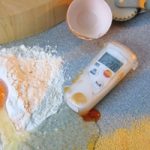The earliest temperature measuring devices date back hundreds of years, to the 16th and 17th centuries when European scientists such as Galileo Galilei collaborated on primitive thermoscopes capable of showing changes in air temperature.
Since then, the technology behind today’s advanced thermometers has grown astronomically in sophistication and accuracy.
Consumers and business users now have access to a wide range of highly precise and intuitive digital thermometers capable of measuring temperatures between -50 and 300 degrees Celsius.
When choosing the right thermometer for your needs, you’ll need to weigh up a number of factors – what environments will you be measuring in? What sort of goods will you be assessing? Is price a concern?
First and foremost, you’ll need to decide whether you want a surface, probe or infrared thermometer. Here is a quick breakdown of a the benefits and applications of each.
Surface Thermometers
Surface thermometers are designed to lie flat on a surface and take an accurate reading of the temperature of the object. They are highly portable and easy to use, and can also be very affordable.
The testo Mini Surface Thermometer offers a probe shaft length of 120 mm and a broad 15 mm measurement tip, making it perfect for measuring the temperature of any flat surface.
Due to the external nature of surface thermometers, they are not ideal for some food preparation tasks, as they do not allow you to assess the internal temperature of potentially hazardous foods such as meats or dairy products.
However, they are great tools for measuring the external temperature of foods and cooking preparation surfaces such as hot plates, griddles, and stovetops. Surface thermometers also have trades and industrial applications.
Probe Thermometers
Probe thermometers are designed specifically for taking internal temperature readings. They feature one or more sharp shafts that can be easily inserted into soft goods to assess the internal temperature of the item.
This is particularly important when dealing with meats and other foods that can have a strikingly different external to internal temperature. While the outside of the good might appear safe, the inside may be above or below the Australia New Zealand Food Standards Code’s safe temperature range.
These devices come in many shapes and sizes. Basic probe thermometers such as the testo Mini Food Thermometer are highly functional and can be purchased in bulk for day-to-day applications.
Alternatively, the testo 108 – Waterproof T/C instrument is a more advanced device with an easily removable thermocouple probe that caters to fast, accurate temperature checks and easy cleaning and maintenance.
Infrared Thermometers
Unlike probe and surface thermometers, infrared thermometers don’t use surface contact to measure the temperature of any particular object or environment.
Instead, they are capable of taking non-contact surface temperature measurements. These thermometers are highly versatile, and offer a number of benefits over traditional devices.
For example, infrared thermometers can be safer than other types of thermometers as instead of having to come into direct contact with an object, users can simply take readings from a safe distance.
The testo 830 T1 – Infrared Thermometer is a good example of a highly accurate and reliable infrared thermometer that uses laser spot marking to pinpoint a location and take a precise reading of the temperature of that area.
In the past, infrared technology has been seen as expensive and difficult to use. However, the testo 830-T1 is a great example of how this technology has become more efficient and intuitive.
For more information on the range of testo thermometers available, get in touch with the experts at testo today.









 Reduce cooking oil costs while ensuring quality
Reduce cooking oil costs while ensuring quality Expert knowledge on CO2 monitoring
Expert knowledge on CO2 monitoring Refrigeration knowledge - in 3 modules
Refrigeration knowledge - in 3 modules



